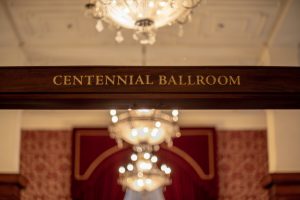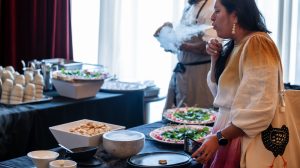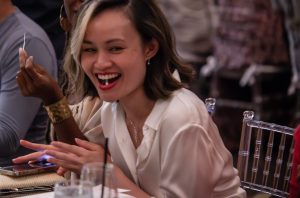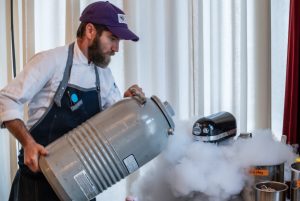The moment you enter the Los Angeles Athletic Club (LAAC) on 7th Street in downtown, you are transported back into history. It feels like you have just stepped into a 1920s noir film, replete with dark velvet curtains, brass, and brown leather. Or as Rick Loverd, Program Director of The Science & Entertainment Exchange, put it simply, “you can practically smell the brandy and cigars.” The LAAC’s aim is to provide a space to celebrate athleticism, culture, and curiosity. And it has been doing that for 143 years! Though not quite as long as the National Academy of Sciences, which was founded 17 years earlier in 1863. It was here, in the LAAC’s Centennial Ballroom, that The Exchange recently put on an epic event, 6 years in the making. An evening of mysterious culinary delights and delightful scientific education—all toward the goal of demystifying taste itself. This was The Periodic Table Dinner.

Photo credit: Zachary Dripps
With more than 100 people in attendance, it was an eclectic mix of LAAC members and entertainment professionals who work with The Exchange. The passed appetizers made it clear at the outset that this was no ordinary dinner: liquefied olives that burst with briny flavor; compressed watermelon spheres that defied physics; cocktails of clarified milk that were, frankly, dangerously delicious. Hidden in the corner was yet another surprise, an interactive food science station that allowed the guests to create their own molten olives and flash freeze “dragon’s breath crackers” that made the imbiber appear to breathe smoke.

Speaker Daisy Vargas tries a “dragon’s breath cracker.”
Photo credit: Zachary Dripps
Next the guests took their seats at the various long tables. Rick formally kicked off the event and passed the mic to the evening’s two hosts and educators, Sheril Kirshenbaum and Daisy Rosa Vargas. Sheril, an Emmy-winning PBS host, scientist, and author, began her talk by making the distinction between taste and flavor. While taste is exactly what it sounds like, flavor entails not only taste but also aroma, texture, and temperature.
Luckily for the guests, taste was the focus of the evening. Taste, this incredible ability that evolved to keep humans alive. Yearning for something salty? Your body is telling you to find minerals or electrolytes. Sweetness correlates to sugary energy. Sour smacks of vitamin C. Despite this basic survival function, everyone’s taste profile is different.
Enter the next mystery of the evening, an unassuming paper strip on every guest’s plate. Everyone placed the strip on their tongues. In that instant, a few dozen folks recoiled in disgust while the rest of us looked around in confusion, we tasted nothing! The paper had been doused with PTC, or phenylthiocarbamide. It is a compound that “super tasters” find extremely bitter while everyone else, us plebian “non-tasters,” lack the ability to notice. Super tasters carry a certain inherited gene that alters their palate on many levels. Those who possess the gene tend to avoid smoking and drinking, but they also avoid eating healthy cruciferous vegetables, which taste too bitter. Non-tasters, meanwhile, tend to like more sugar. Next, Daisy Rosa Vargas, an educator with a Ph.D. in organometallic chemistry, guided the guests through the evening’s four-course meal. Fair warning, if you are reading this while hungry, this next part may grow unbearable…

A guest tests to see if she is a “super taster.”
Photo credit: Zachary Dripps
First, the starter. A delicate arrangement of hamachi, nuoc cham sauce, avocado, and grapefruit along with one key ingredient, a bowl of butterfly pea tea that seemed to be brooding in a striking dark blue. After pouring it over the starter, the dish turned a vibrant purple. And it tasted pretty darn amazing too. Its defining elements: fluorine, magnesium, and oxygen.
Second, a zesty bone broth with broccoli stems, turmeric, black pepper, and cayenne. Daisy explained how broths extract the flavors and nutrients from otherwise inedible organics, like bones. Elementally, the broth delivered calcium, magnesium, phosphorus, and sulfur. Following that, a sumptuous bison short rib with allium, broccoli, mushroom, carrot, and natural jus. Beneath it all, copper, sulfur, iron, and iodine. So far, we had traveled from bitter to sour, sour to umami.
Finally, came dessert. A spongy and caramelized banana bundt cake topped with ice cream (sodium, potassium, and calcium). The hosts demystified yet another age-old question: what is ice cream exactly, solid or liquid? Neither, in fact, it is an emulsification: a foamy and delicate suspension of milk molecules and ice crystals.
Just when the guests were full to the brim with both food and knowledge, the star behind the evening finally came out, Chef Marcel Vigneron. Trained at the Culinary Institute of America, Chef Marcel is a Top Chef competitor famous for his feats in molecular gastronomy. One got the sense that he preferred to stay in the back and let his creations do the talking.

Chef Marcel preparing one of the evening’s delights.
Photo credit: Zachary Dripps
Chef Marcel informed the guests that there was one final dish to come: a flower, a pill, and a slice of lime. Three simple items to subvert and thrill the senses. The pill was revealed to be miracle fruit, otherwise known as Synsepalum dulcificum, an African berry that binds to the tongue’s taste buds and causes sour foods to turn sweet. It tricks the tongue and in turn, the mind. In part, it is a miracle for what it has done to help cancer patients find appetite again. After chewing on the tasteless pill, the guests got to experience a usually sour lime garner the taste of something more akin to a sugary lemon drop. Those who then tried their dry Cabernet wine suddenly found it tasted like thick syrupy Port.
Finally, the flower—an unassuming yellow bud called a buzz button. One of its key ingredients, spilanthol, delivers an electrifying sensation to the tongue that lives up to its name. A sort of salivating, cool numbing feeling. The buzz button was the perfect finale for the event. It delivered a shock of flavor that awakened you to a strange reality, the human body is nothing more than chemical processes that can be experimented with and manipulated to no limit. The flower left the guests buzzing for more.
Writer/producer Aaron Brownstein said of the experience “I was hoping that this [event] would be exactly what it was but I can’t believe it now that I’m here. It’s been an utter delight and fascinating.”
Special thanks to the Howard Hughes Medical Institute, the Alfred P. Sloan Foundation, and individual donors who made the event possible.






